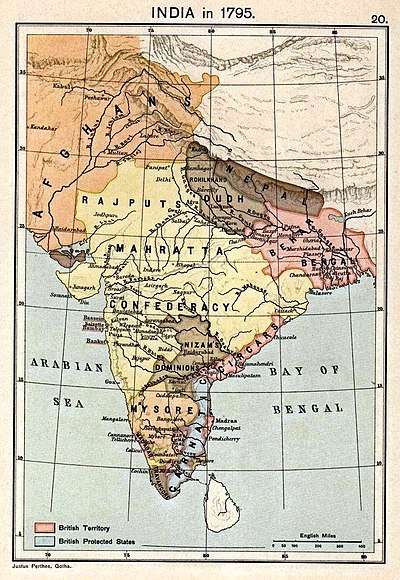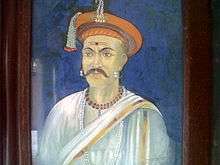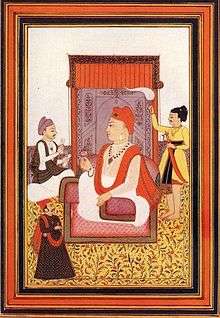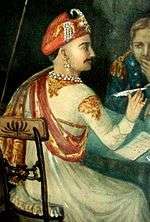Peshwa
A Peshwa was a Prime Minister of the Maratha Empire of the Indian subcontinent. Originally, the Peshwas served as subordinates to the Chhatrapati (the Maratha king), later they became the leaders of the Maratha Confederacy, and the Chhatrapati became a nominal ruler. During the last years of the Maratha Empire, the Peshwas themselves were reduced to titular leaders, and remained under the authority of the Maratha nobles and the British East India Company.
| Peshwas of Maratha Empire | |
|---|---|
| Residence | Shaniwar Wada (1732-1818) |
| Appointer | Chhatrapati (until 1713) Hereditary (1713–1818) |
| Formation | 1674 |
| First holder | Moropant Trimbak Pingle |
| Final holder | Bajirao II |
| Abolished | 3 June 1818 |
| Succession | None |
All the Peshwas during the rule of Chhatrapati Shivaji, Sambhaji and Rajaram belonged to Deshastha Brahmin community.[1][2] The first Peshwa was Moropant Pingle, who was appointed as the head of the Ashta Pradhan (council of eight ministers) by Chhatrapati Shivaji, the founder of the Maratha Empire. The initial Peshwas were all ministers who served as the chief executives to the king. The later Peshwas held the highest administrative office and also controlled the Maratha confederacy. Under the Chitpavan Brahmin Bhat family, the Peshwas became the de facto hereditary administrators of the Confederacy. The Peshwa's office was most powerful under Baji Rao I (r. 1720-1740). Under Peshwa administration and with the support of several key generals and diplomats, the Maratha Empire reached its zenith, ruling major areas of India. The subsequent Peshwas brought in autonomy and as a result later on many provinces were controlled and administered by the Maratha nobles such as Daulat Rao Sindhia or Gaikwads.
First use

The word Peshwa is from Persian پیشوا pēshwā, meaning "foremost, leader".[3] After the coronation of Shivaji in 1674, he appointed Moropant Trimbak Pingle[4] as the first Peshwa. Shivaji renamed this designation as Pantpradhan in 1674 but this term was less commonly used. Moropant Trimbak Pingale's son, Nilopant Moreshvar Pingale, succeeded him during Sambhaji's rule after Moropant's death in 1683.[5]
Ramchandra Pant Amatya (Bawadekar)
Ramchandra Amatya recaptured many forts from the Mughals between 1690 and 1694, some in person, as well as personally conducting guerilla war techniques. When Chhatrapati Rajaram fled to Jinji in 1689, before leaving from Maharashtra, he gave "Hukumat panha" (King Status) to Pant. Ramchandra Pant managed the entire state under many challenges such as the Mughal influx, the betrayal of Vatandars (Feudal Chiefs), and scarcity of food. With his help, Sachiv kept the Maratha State on a sound economic footing.[6]
Bhat Family


The Maratha war of succession between Tara Bai and Shahu resulted in latter's victory and assumption of Maratha throne as Chhatrapati. In 1713, Shahu appointed Balaji Vishwanath (Bhat), as Peshwa. The appointment of Balaji's son, Baji Rao I, as Peshwa in 1719 by Shahu made the position hereditary in the Bhat family. Baji Rao proved his loyalty by controlling the feudal chieftains who wanted independence from the Maratha Empire. The rebellion of General Trimbak Rao Dabhade, the senapati (commander in chief), over Chauthai (revenue collection) of Gujarat is one example of such internal Maratha feuds. The followers of Baji and Trimbak clashed at the Battle of Bilhapur on April 1, 1731, and Trimbak was killed. In gratitude, Shahu gave the Peshwas and the Bhat family unchallenged control over Maratha empire.[7] who also appointed Baji Rao's son as Peshwa in 1740, gave considerable authority to the Peshwas to command the Maratha armies, and they responded well during his reigns.
At the time of his death in 1749, Shahu made the Peshwas his successors under these conditions: Shivaji's descendants, who remained as the titular Raja of Satara, were called Swami (Marathi for the 'real owner') by the Peshwas who reported to them, and officially they were to seek guidance from the Raja. However, the Peshwa also became a ceremonial head of state after the battle of Panipat and the death of Madhavrao.
Legacy
The first Peshwa to receive the status of a pantpradhan was Ramchandra Pant Amatya Bawdekar in 1689 by Chhatrapati Rajaram. The first (Bhat) Deshmukh family Peshwa was Balaji Vishwanath (Bhat) Deshmukh. He was succeeded as Peshwa by his son Baji Rao I, who never lost a battle. Baji Rao and his son, Balaji Baji Rao, oversaw the period of greatest[8] Maratha expansion, brought to an end by the Marathas' defeat by an Afghan army at the Third Battle of Panipat in 1761. The last Peshwa, Baji Rao II, was defeated by the British East India Company in the Battle of Khadki which was a part of Third Anglo-Maratha War (1817–1818). The Peshwa's land (Peshwai) was annexed to the British East India Company's Bombay province, and Bajirao II, the Peshwa was pensioned off.
List of Peshwas
Peshwas appointed by the Chhatrapatis
| Sr. | Name | Reign Began C.E. | Reign Ended C.E. |
|---|---|---|---|
| 1 | Moropant Trimbak Pingle | 1674 | 1683 |
| 2 | Nilakanth Moreshvar Pingale | 1683 | 1689 |
| 3 | Ramchandra Pant Amatya | 1689 | 1708 |
| 4 | Bahiroji Pingale | 1708 | 1711 |
| 5 | Parshuram Trimbak Kulkarni | 1711 | 1713 |
Hereditary Peshwas from Bhat family
| Sr. | Name | Particulars | Reign Began C.E. | Reign Ended C.E. | Portrait |
|---|---|---|---|---|---|
| 1 | Balaji Vishwanath (Sixth appointed Peshwa) | Assisted the Syed Brothers in deposing the Mughal Emperor Farrukhsiyar in 1719 | 1713 | 1720 |  |
| 2 | Baji Rao I | Known as Thorle (elder) Bajirao and acknowledged as the most influential of the nine Peshwas. Said to have fought for the establishment of "Hindu Pad Padshahi"(Hindu Empire). Helped conquer Central India (Malwa) and Rajputana and extended his dominions into Gujarat in the northwest and Deccan in the south. Raided Mughal Delhi in 1738. Fought in over 41 battles and is one of the few to have never lost a single battle. Died at the age of 40 of sudden fever in camp en route to Delhi; he has been commemorated in the form of an equestrian statue erected at Shaniwar Wada in Pune. | 1720 | 1740 |  |
| 3 | Balaji Bajirao | Known as Nanasaheb Peshwa. Managed to extend the Maratha territories into most of North-West, East and Central India. Captured Attock on the banks of Indus River and Peshawar in 1758 in the Battle of Attock, 1758. Under his leadership, the Maratha Empire reached its peak but his general and cousin lost the Third Battle of Panipat against Ahmad Shah Abdali in 1761. Contributed to the development of the city of Pune which was the seat of the Peshwas. Built the famous Parvati Temple, Lakdi Pool and established Nana Peth (area) in Pune. Built a water reservoir near Katraj to provide clean water to Pune city; this 250-year-old system is still functioning. | 1740 | 1761 |  |
| 4 | Madhav-Rao I | Fraught with internal dissensions and successful Wars with the Nizam. During his tenure, Maratha power recovered from the losses suffered during the Third Battle of Panipat, a phenomenon known as Maratha Resurrection. Repaired the recently weakened administration, treasury, and accounts of the Maratha Empire. He died of tuberculosis in 1772; a memorial commemorating his greatness stands at Peshwe Park in Pune. | 1761 | 1772 |  |
| 5 | Narayan-Rao | Assassinated by Gardi guards | 1772 | 1773 |  |
| 6 | Raghunath-Rao | Responsible for extending the Maratha empire to the zenith in the North as a General and also saw the decline of Maratha power in North India. Deposed by Nana Phadnis and 11 other administrators in what is now called "The Baarbhai Conspiracy" | 1773 | 1774 |  |
| 7 | Madhav-Rao II | Appointed Peshwa as an infant with a council of Maratha Generals and ministers as regents. Era dominated by the political intrigues of Nana Phadnis. Saw the resurgence of Maratha power in North India. | 1774 | 1796 |  |
| 8 | Baji Rao II | 1st Reign - Was defeated by Yashwantrao Holkar, ruler of Indore, at the Battle of Poona. Fled to British protection, and in December 1802, concluded the Treaty of Bassein with the British East India Company, ceding territory for the maintenance of a subsidiary force and agreeing to treaty with no other power. This provoked the Second Anglo-Maratha War that began the breakup of the Maratha confederacy. | 1796 | 1802 |  |
| 9 | Amrut Rao [9][10] | Appointed Peshwa by Yashwantrao Holkar after defeating Baji Rao II and Daulat Rao Sindhia in Battle of Poona. | 1802 | 1803 | |
| 10 | Baji Rao II | 2nd Reign - During his second reign began the Third Anglo-Maratha War. After the defeat at the Battle of Koregaon in January 1818, he was on the run from the British. Eventually, the British took over his dominion and made the Maratha King Pratap Singh of Satara declare in favour of the British. This ended the Peshwa's legal position as head of the Maratha confederacy. On 3 June 1818, Baji Rao surrendered to the British; he was banished to Bithur near Kanpur. | 1803 | 1818 |  |
| 11 | Nana Sahib | Was a leader during the Indian Uprising of 1857. As the adopted son of the exiled Maratha Peshwa Baji Rao II, he sought to restore the Maratha confederacy and the Peshwa tradition. | 1851 | 1857 |  |
Notable generals and diplomats

- Annaji Datto Sacheev
- Balaji Deshpande
- Balaji Kunjar
- Chimnaji Damodar Moghe
- Chimnaji Deshpande
- Govind Pant Bundele
- Ibrahim Khan Gardi
- Keso Narayan Deshpande
- Mahadji Shinde
- Malharrao Holkar
- Ramchandra Malhar Sukhtankar
- Jivabadada Kerkar Bakshi
- Jaghanath Ramkrishna Bakshi
- Melgiri Pandit
- Sadashivrao Dev (Gade)
- Gopalrao Patwardhan
- Nana Phadnawis
- Neelkanth Sarnaik
- Niranjan Madhav Parasnis
- Parshuram Pant Pratinidhi
- Pilaji Rao Gaekwad
- Ragho Ballal Atre
- Rahuji Somanath
- Ranoji Scindia
- Sadashivrao Bhau
- Trimbakrao Mama Pethe
- Visaji Krushna Biniwale
- Santaji Ghorpade
- Bapu Gokhale
See also
References
- Prasad 2007, p. 88.
- Vasant S. Kadam (1993). Maratha Confederacy: A Study in Its Origin and Development. Munshiram Manoharlal Publishers. p. 49.
Under Shivaji the Great, Sambhaji and Rajaram all the incumbents of the office of Peshwa were from the Deshastha (residing in the Desh area of Maharashtra) subcaste of the Brahmans.
- under Jahangir, M. Learning focus. Longman History & Civics ICSE 7, 84.
- Kulkarni 1996, p. 47.
- Joshi 1980, p. 112.
- Surendranath Sen, Surendra Nath Sen (1993). Studies in Indian History: Historical Records at Goa. Asian Educational Services. p. 42.
- Encyclopædia Britannica, Micropædia Vol. II, p17
- Shirgaonkar, Varsha S. "Peshwyanche Vilasi Jeevan" (Luxurious Life of Peshwas). Continental Prakashan, Pune (2012). ISBN 8174210636. In Marathi.
- Wg Cdr (Retd.) Dr. M. S. Narawane, Battles of the Honourable East India Company. pg 65
- Jadunath Sarkar, Fall of the Mughal Empire:1789-1803. pg 179
Bibliography
- Kulkarni, A.R (1996). Marathas and the Marathas Country: The Marathas. Books & Books.
- Joshi, Pandit Shankar (1980). Chhatrapati Sambhaji, 1657-1689 A.D. s.chand.
